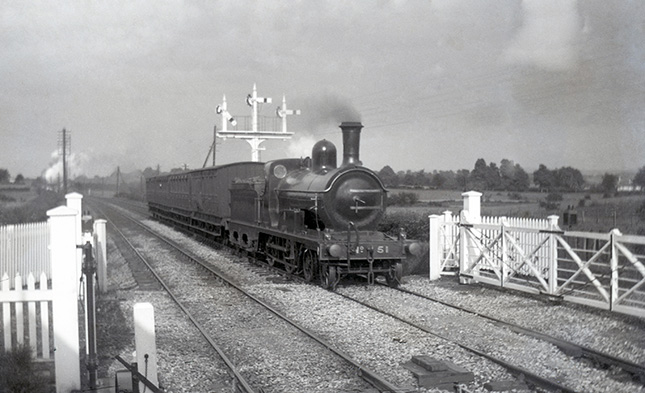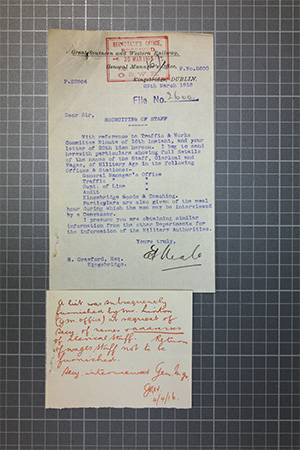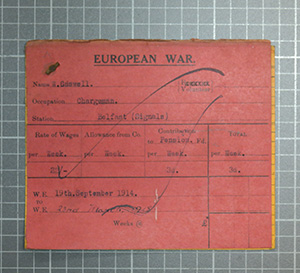Keeping on track
Published in Features, Issue 1 (January/February 2017), Volume 25, World War ILABOUR, ENLISTMENT AND DEMOBILISATION IN IRELAND’S FIRST WORLD WAR RAILWAYS
By Peter Rigney

Above: The Belfast to Antrim train at Knockmore junction c. the 1910s. (Major-Gen. Sir Cecil Smith/Friel Collection)
In the early weeks of the First World War, British railway companies were taken under government control. The companies obtained a commitment that no railwayman would be accepted into the forces without the permission of his employer. Irish companies were not thought to be sufficiently important to be taken over. In Ireland the railway companies consulted informally on wages and conditions of staff. The Great Northern Railway (GNR) treated men enlisting in the same manner as had applied during the Boer War, while the Great Southern and Western Railway (GSWR) established a package of supports for employees who enlisted.
In November 1915 the viceroy, Lord Wimbourne, wrote to the railway companies to ask for their cooperation in a recruitment drive. Sir William Goulding, chairman of the GSWR, replied on behalf of the companies. He asked for the same assurance that the British companies obtained in 1914 (a veto on the enlistment of their employees). The recruiting authorities gave the assurance on condition that the companies would co-operate with recruitment efforts. At this time 623 (6.9%) of the GSWR’s 9,010 employees were in the forces.
Labour shortages
The wartime manpower shortages meant that employers had to make do with less labour. In 1915 a Wicklow track worker ‘resigned owing to low wages on the railway and stated he was taking up a position with Kynochs [the Arklow explosives manufacturer]’. In October 1915 the locomotive engineer of the GSWR approached the board with a proposal to increase the wages of locomotive cleaners by 2/- per week, as ‘we are experiencing great difficulty in getting these lads’.
On 23 November 1915 a meeting of Dublin employers was held in the Mansion House, where a committee was established to promote recruitment. A letter, enclosing an enlistment form, was sent to all permanent railway employees. The GNR decided in December 1915 to ‘allow every volunteer to go … who could possibly be spared even at the sacrifice of some degree of efficiency’. In February 1916 Goulding wrote to Wimbourne: ‘I was greatly disappointed on hearing … of the poor response made by our railwaymen … I shall make a strong appeal to them at our shareholders’ meeting’.
On 1 March 1916 the Department of Recruiting wrote to all employers in the Dublin area, asking them for a list of their employees in the 18–41 age category and for permission for military canvassers to approach such men in their workplace. The GSWR submitted only the names of clerical staff, holding back on manual grades. We thus have the strange situation of a company chaired by a prominent member of the southern unionist establishment (and Irish privy council member from 1917) shielding his blue-collar workforce from military recruiters.
Enlistment—the evidence
The GSWR traffic department ledger contains about 4,500 names of men of military age, of whom 175 (3.8%) enlisted. Recruitment was an overwhelmingly urban experience, with 53% of those who served coming from Dublin, Cork, Limerick and Waterford. The absence of recruits is noteworthy in the large provincial barrack towns such as Athlone, Fermoy or Clonmel.
The civil engineering department was organised in three divisions: Dublin, Cork and Limerick. The workforce was mainly unskilled and overwhelmingly rural. Most workers were ex-agricultural labourers and shared the lack of enthusiasm of that class for enlistment. Enlistment rates declined the further one got from Dublin: 5.9% for the Dublin division, 2.5% for Cork and 2.1% for Limerick.
The majority of GSWR fatalities were from the mechanical engineering department, so we may safely assume that it produced the largest proportion of recruits. Wage ledgers do not survive for this department, but comprehensive lists do survive of those returning to employment, and of those who died. By using pension applications made between 1918 and 1921 as a proxy for the workforce as a whole, we can compare the skill balance of the labour force with the skill balance of those who had enlisted.
| Category | Skilled | Semi-skilled | Unskilled |
| Pension % | 36 | 36 | 28 |
| Killed % | 19 | 49 | 32 |
| Returned % | 16 | 49 | 35 |
Tradesmen were under-represented, but they were less likely to be released. Unskilled labourers were over-represented but not as significantly as the semi-skilled, who were hugely over-represented. One possible reason for this was the tendency for companies to employ large numbers of ex-soldiers as semi-skilled workers. Another incentive for the semi-skilled to enlist was to gain a new skill in the army, as in civilian life they would have been excluded from promotion by craftsmen and their unions. Eoghan Ó Tuarisc’s father, who was a shoemaker, served in the Connaught Rangers. He was trained as a car mechanic in the army, and on his return to Ballinasloe ‘in ionadh tabhairt faiona sheancheird cheannaigh se charr agus thosaigh sé seirbhis tacsai’. In the Dundalk Democrat of August 2005, an article on a local bus firm states that it ‘was started by Joe Halpenny after he returned […] from fighting in the First World War where he had served in a cavalry unit in the Middle East’.
The GNR served an area where recruitment rates were politically contentious. Of the 665 staff who served, 253 index cards survive. In contrast to the departmental analysis of the GSWR, I have compared the pattern of enlistment in the company with the geographic pattern of employment, using locomotive crew numbers as a proxy for total employment.
| Location | Soldiers % | Loco. crew % | Divergence |
| Belfast | 30.8 | 26 | + 4.8 |
| Dublin | 13.4 | 11.5 | +1.9 |
| Dundalk | 14.2 | 14.2 | +0.0 |
| Portadown/Lurgan | 7.5 | 12 | -4.5 |
| Newry | 5.1 | 4 | +1.1 |
| Enniskillen | 3.5 | 6 | -2.5 |
| Derry | 1.9 | 6 | -4.1 |
| Clones | 3.0 | 6.6 | -3.6 |
| Other locations | 20.6 | 13.7 | |
| Total | 100 | 100 |
The willingness to volunteer declined west of the Bann. There were three categories of returning veterans: wounded ex-railwaymen, who began to return as early as 1914; demobilised ex-railwaymen, who were reinstated in their old jobs once they passed a medical examination; and demobilised ex-soldiers, with no previous railway connections, seeking employment.

Above: R. Crawford, secretary of the GSWR, a prominent member of the southern unionist establishment, responds to a Department of Recruiting request for a list of employees of military age. Blue-collar workers were to be excluded—and, in the appended note, so too were wages staff. (NAI)
Above: R. Crawford, secretary of the GSWR, a prominent member of the southern unionist establishment, responds to a Department of Recruiting request for a list of employees of military age. Blue-collar workers were to be excluded—and, in the appended note, so too were wages staff. (NAI)[/caption] Above: R. Crawford, secretary of the GSWR, a prominent member of the southern unionist establishment, responds to a Department of Recruiting request for a list of employees of military age. Blue-collar workers were to be excluded—and, in the appended note, so too were wages staff. (NAI)[/caption]In August 1917 the GSWR stores superintendent requested permission from the board to re-employ ‘one of my best men who returned from war minus his arm, but otherwise healthy … It is most desirable that I should have him back as soon as possible’. Further employment of wounded ex-soldiers was delayed by difficulties in the company’s insuring them under the workmen’s compensation legislation. Once this was resolved by the Home Office, the way was paved for the re-employment of the wounded. Fit railwaymen who passed the medical were reinstated, and in some cases they were promoted to the grade they would have attained had they not joined up.
Family connections
Railway employment was frequently family-based. Altering these arrangements provoked action at the highest level. For example, from December 1919, where an ex-soldier applied for a post in the GSWR and was declined, the chairman was to be informed. The board ordered in January 1920 that all vacancies for porters should be filled by ex-soldiers.
This caused tensions. From June 1920 the munitions strike took hold, with hundreds of men being dismissed. In October 1920 the general manager of the GSWR reported that ‘ticket checker O’Connell asked me to give a few days work to a relative … I took him on but he knocked off on the first day before his time was up … O’Connell later informed me that he was arraigned before the men’s society for introducing a temporary man.’
In the spring of 1919 there was a once-off demand for extra labour owing to the granting of the eight-hour day, causing staff numbers to grow by roughly 10%. Nearly 40% of this increased employment was among locomotive crew, however, whose entry grade had an upper age limit of nineteen. Additionally, in April 1919 the companies had agreed that ‘for each outside (trade) apprentice at least three sons will be taken on’.
A ledger of applications for employment survives for the GSWR civil engineering department. Between September 1918 and September 1922, 303 ex-servicemen applied, of whom 49.9% received an offer of employment. Of the offers of employment made in this period, 62.5% went to ex-servicemen. Ex-soldiers were refused employment for being too old, for having a bad previous work record or for various wound-related disabilities.
The effectiveness of GSWR recruitment policies is confirmed by the intelligence department of the IRA’s Cork No. 1 Brigade, in a memo to IRA GHQ just before the truce:

Above: The war record card of Belfast chargeman G. Saswell. (NAI)
‘About the end of 1919 a circular was issued … stating that only ex-soldiers were to be taken on as temporary men. This year … the traffic got light and all … the temporary men were dismissed. All the ex-soldiers were safe as they were appointed porters. Traffic is now becoming normal again … Ex-soldiers will again get preference for employment. Those on whom we can depend will be kept out and the goods dept. turned into a soldiers’ home.’
Recruitment lower than in Britain
It is instructive to compare these rates with the rates for British railway companies. The other GSWR—the Glasgow and South Western Railway, almost identical in size to the Irish GSWR—had 320 names on its plaque in Glasgow’s St Enoch’s station, commemorating those killed in the war. This gap in enlistment levels was apparent before the introduction of conscription in Great Britain.
Comparing British and Irish enlistment rates in the same industries, the overwhelming fact is not how many Irishmen served but how few. If Irish railwaymen were reluctant to enlist, Irish companies became reluctant to make labour scarcer and dearer by encouraging recruitment. About 9% of Irish railwayman enlisted, with the GNR rate of 12% being an outlier.
Company Served Killed % served
DSER 102 10 9
GNR 665 67 12
GSWR 736 79 7.9
MGWR 237 46 8
Ex-soldiers had to compete with three other groups for employment: members of the network of existing employees and shareholders; those who would have emigrated in peacetime but who remained in the country during the war; and, after 1923, ex-Free State soldiers. The only way that ex-soldiers might have done better was if restrictions for apprenticeships had been relaxed. This would have been difficult in Britain and impossible in Ireland.
After the war, veterans would have blended into the common identity of railwayman. The identity of ex-soldier would have come to the fore around Armistice Day, when railway ceremonies were held in Kingsbridge and Amiens Street stations and in Inchicore works. The narrative of Irish servicemen in the Great War has stressed negative experiences on their return, with an emphasis on physical danger, discrimination in the labour market and a lack of commemorative events. This does not ring true for the railway companies, who treated their enlisting staff generously while striving to allocate as many post-armistice vacancies as possible to returning soldiers.
Peter Rigney is an Industrial Officer with the Irish Congress of Trade Unions and assistant archivist of the Irish Railway Record Society.
FURTHER READING
P. Taylor, Heroes or traitors? Experiences of Southern Irish soldiers returning from the Great War 1919–39 (Liverpool, 2015).
P. Yeates, A city in wartime: Dublin 1914–1918 (Dublin, 2011).
















